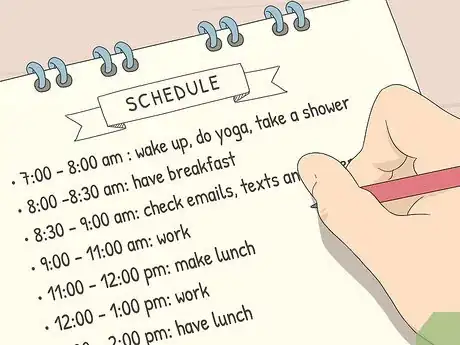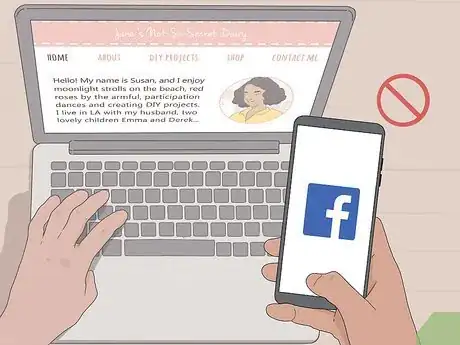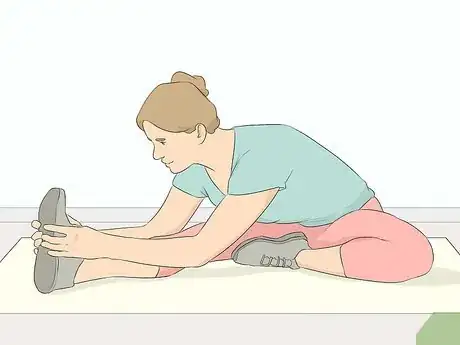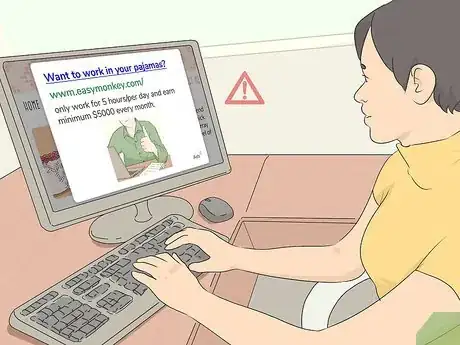This article was co-authored by Annie Lin, MBA and by wikiHow staff writer, Megaera Lorenz, PhD. Annie Lin is the founder of New York Life Coaching, a life and career coaching service based in Manhattan. Her holistic approach, combining elements from both Eastern and Western wisdom traditions, has made her a highly sought-after personal coach. Annie’s work has been featured in Elle Magazine, NBC News, New York Magazine, and BBC World News. She holds an MBA degree from Oxford Brookes University. Annie is also the founder of the New York Life Coaching Institute which offers a comprehensive life coach certification program. Learn more: https://newyorklifecoaching.com
There are 18 references cited in this article, which can be found at the bottom of the page.
This article has been viewed 75,507 times.
Transitioning to a remote position can give you a lot of flexibility and freedom, but it can also sometimes feel a little tough to clear out distractions and get into "work mode." We'll show you some tips on how you can make this a lot easier.
Steps
Getting Organized
-
1Set aside an area in your home for work. When you’re working from home, it’s important to set clear boundaries between your work and your regular home life. Whether it’s a desk in a home office or a spot at the kitchen table, designate a spot that you use specifically for work-related activities.[1]
- Pick a spot that’s quiet, well-lit, comfortable, and roomy enough so that you can spread out any materials you need for your work.
- Avoid working in places where you normally relax or sleep, like the couch or your bed. You may be tempted to fall asleep!
- If possible, set aside a dedicated room for work. Ask your family members or anyone else who shares your home not to disturb you while you’re working there unless it’s urgent.
-
2Declutter your workspace. Get rid of anything you don't need while you're at work. Knick knacks and family photos are ok, but anything else should be put in another room (or at least away from your workspace). You need to create a clean space that’s free of distractions. At the end of every day, do some basic maintenance to your organization system, and make sure any work-related materials are put away properly. This way, when you arrive in the morning, you won't be confronted with a mess.[2]
- If your workspace tends to get cluttered or messy, set aside 15 minutes each day for tidying it up.
Advertisement -
3Keep your work supplies close by. Arrange your work area with all the "office" tools you need, such as your printer, computer, and any paper documents you’ll be working on. Place items where they’ll be easily accessible and you can find them immediately when you need them.[3]
- If you find yourself regularly getting up to search for an item (such as a pair of scissors or a pen), move that item permanently into your workspace. Set aside a specific area for it where it’s easy for you to find.
- Other items you may find helpful include a power strip, chargers for your electronic devices, a pad of paper and pen for jotting down notes, drinking water, and snacks.
-
4Set a daily schedule and stick to it. Even if you get to set your own hours, keeping a consistent schedule is an important part of working from home successfully. Decide what your daily work hours will be, and set that time aside just for work.[4]
- Try to choose hours that work well for you. For example, if you’re a morning person, you might choose to start working earlier in the day so that you’re energized when you begin working on your high-priority tasks.
- To help maintain a good work/life balance, you can also block out specific times for other obligations, such as chores, meals, and spending quality time with friends and family.
Tip: When you’re working from home, interruptions are inevitable, especially if you have a family. Try to incorporate those interruptions into your routine—for instance, set aside 20 minutes for chatting with your child and making them a snack when they come home from school in the afternoon.[5]
-
5Set aside 30 minutes to create a prioritized to-do list for the day. Before you start work, take half an hour to plan your day.[6] Write out a list of tasks you need to complete, placing the most important or complex tasks at the top. As you complete each task, take a moment to cross it off your list or add a star to indicate that it’s complete. This will help keep you motivated during the day.
- For example, you might put a time-consuming task like drafting an article at the top of your list, while putting in a quick order for some new office supplies might go lower on the list.
- Try to block out specific times for each task, since this can help them feel more manageable.[7]
- You can also break down larger tasks into smaller chunks. For example, instead of just putting “Write a blog post” on your to-do list, you might break it down into “Do research,” “Write an outline,” “Draft the post,” and “Edit post.”
-
6Develop a regular routine around your work hours. In addition to keeping a consistent work schedule, it can be helpful to develop a set daily routine. Find a groove that works for you and make time each day for meals, breaks, and specific activities or rituals that help you maintain your energy and work flow (such as having a cup of coffee first thing in the morning or taking a 15-minute break to read your favorite blog in the late afternoon).[8]
- For example, you might spend half an hour having your breakfast and morning cup of coffee, then another half hour planning out your day. Establishing a consistent morning routine can help energize you and get you into the right headspace for work.
-
7Avoid social media and other distractions. Distractions around the home can be a huge productivity killer. Help yourself maintain a productive routine by putting away your phone and avoiding time-wasting websites like Facebook and YouTube while you’re working. Avoid working around other sources of distraction, such as TVs or radios.[9]
- Consider installing an app or browser extension on your phone or computer to keep you away from time-wasting apps and websites. Apps like StayFocusd and Strict Workflow are great for keeping you on task.
- If you share your home with other people, explain to them that you need to be left alone while you’re working. Ask your friends to keep calling and texting to a minimum during your work hours.
Maintaining a Professional Attitude
-
1Dress like you would if you were going to work. You may be tempted to work in your pajamas every day, but taking the time to get dressed can help get you into the right mindset for work. Even if you aren’t going anywhere or planning on a video conference with your boss, put on some clothing so that you don’t always feel like you’re in relaxation mode.[10]
- This doesn’t mean you have to put on a nice blazer or a tie, although that’s fine if it helps you get into the right zone. Just put on some clean, daytime-appropriate clothes.[11]
- Take time to attend to the rest of your grooming, too. Take a shower, brush your teeth and hair, and do any of the other things you would normally do to prepare for a day at work.
-
2Keep a professional tone with coworkers and clients. Even though you’re working at home instead of in an office building, it’s still important treat your work like work. When you communicate with bosses, fellow employees, and clients or customers, speak to them the same way you would if you were working on-site. Stay courteous, polite, and congenial. Edit your emails and other written communications carefully to avoid grammar and punctuation errors.[12]
- Respond to calls, chat communications, and emails in a timely manner. This will let your bosses, coworkers, and clients know that you are taking your work and their needs seriously.
-
3Check in frequently with your employer and coworkers. Staying in the loop and keeping the lines of communication open are important when you’re working from home. If you’re working for an employer rather than running your own home business, try to check in occasionally. Give updates on how you’re doing, ask any questions you may have, and find out if there are any new developments that you should know about.[13]
- Take advantage of multiple forms of communication, such as email, chat programs like Slack, your phone, or video calling programs such as Skype or Zoom.
- Staying in touch can also help working from home feel less lonely and isolating.
-
4Avoid dealing with work-related matters after work hours. Avoid blurring the boundaries between work time and down time by getting out of “work mode” at the end of the day. Close your work chat program, stop checking your business email, and let work calls go to voicemail. Dedicate that time to relaxing, spending time with your family, and taking care of tasks that aren’t work-related.[14]
- Similarly, don’t let your personal life bleed into your work time. Avoid chatting with friends or doing time-consuming household chores while you’re supposed to be working.
Staying Active and Healthy
-
1Leave your home for extended periods of time when you can. If spend your entire day—working and not working—at home, you’ll quickly get sick of being there. Make a point of going out during your downtime. Go to restaurants, movie theaters, shopping centers, sporting events, local concerts, and anything else that takes place outside your home.
- You can also try getting out during your work hours. If you need a change of scene while you’re working, you might try setting up your laptop at your favorite coffee shop or in a quiet corner at the public library.[15]
Tip: If you have kids at home, working at an indoor playground can be a great option. Your kids will stay busy while you get a change of scenery!
-
2Schedule physical activity into your daily routine. Exercise is important for your physical and mental health. Sitting at your work area for hours every day will eventually lead to fatigue, lack of motivation, and disinterest. Keep yourself healthy by making time to get moving, even if it’s just a 15-minute walk after lunch.[16]
- Getting a little exercise during the day can boost your mood and help you feel more energetic, leading to greater productivity.[17]
- Even if you don’t have the time to join a gym or do an extended workout every day, try to go for a walk or a quick jog most days of the week.
-
3Take movement breaks during work. Try to get up at least once an hour and move around a little. Do some light stretching, pace around the room, or even go for a quick walk outside.[18]
- Moving around occasionally will help energize you, promote better circulation, and improve your mood and productivity levels.
- You can even use your breaks to get quick chores done, like taking out the trash or going to check the mail.
-
4Make time for healthy meals and snacks. It can be easy to forget to eat and drink when you’re wrapped up in work, but staying well-nourished will help keep you healthy and improve your energy levels. Eat a healthy breakfast before you start work, and make sure to take a lunch break every day.[19]
- Keep a supply of healthy snacks and meals in your fridge and pantry at home so you won’t be scrambling to find something good to eat.
- Don’t forget to drink water throughout the day, since being dehydrated can cause you to feel fatigued and unfocused.
Finding At-Home Jobs
-
1Watch out for offers that seem too good to be true. When you see an ad that says, “Earn thousands of dollars from your comfy couch,” “Want to work in your pajamas?” or “Set your own hours working at-home,” be cautious. If it seems too good to be true, then it probably is. Research the company before you apply to make sure it’s legitimate. Other common signs of a scam include:[20]
- Claims that there’s no special experience or skill needed for the job
- Offers of large amounts of pay for little work
- Requests for upfront payment from you in exchange for training, certification, or work materials
-
2Check reputable news sources and career websites for leads on jobs. Many online news sources and career-building websites compile lists of reputable at-home job sources. These websites can be found through basic internet searches. Just be sure to avoid websites for services you’ve never heard of before.[21]
- Check out sources such as Forbes, FlexJobs, Glassdoor, and the Better Business Bureau for information about legitimate work-at-home opportunities.
-
3Brainstorm ways to use your special skills for at-home work. When you think of working at home, you might jump straight to things like freelance writing or web design. However, the range of jobs you can do from home might be wider and more variable than you think. Explore a variety of different options based on your unique knowledge, skills, and experience. For example:[22]
- Jobs that require a lot of typing or editing can be great work for at-home workers. Think about becoming a medical or legal transcriptionist. Similarly, positions that require help with schedules, like personal assistant or receptionist work, can be done online and over the phone. Pay for virtual assistants can range from $15 an hour to over $100 an hour.[23]
- Do you speak more than one language? Many websites build content in multiple languages and look for people who can edit their multilingual content.
- Do you have great people skills and know a lot about traveling? Consider being a travel agent from the comfort of your own home. Many booking companies hire at-home workers to answer phone calls and work with customers online.
-
4Show off your special skills to potential employers. Think about the skills you need to work at home. Just like with any job, emphasize the skills in the job ad that apply to you best. Then focus on what makes an efficient employee who works from home. Emphasize your organizational skills and your ability to self-motivate as well what elements of your home lend themselves to occupational success. For example:
- Do you have dedicated space to work from home?
- Do you have a phone and internet access?
- Are you good at working under pressure and meeting deadlines?
- Can you work well without a lot of supervision?
Expert Q&A
Did you know you can get premium answers for this article?
Unlock premium answers by supporting wikiHow
-
QuestionHow do you manage working from home?
 Annie Lin, MBAAnnie Lin is the founder of New York Life Coaching, a life and career coaching service based in Manhattan. Her holistic approach, combining elements from both Eastern and Western wisdom traditions, has made her a highly sought-after personal coach. Annie’s work has been featured in Elle Magazine, NBC News, New York Magazine, and BBC World News. She holds an MBA degree from Oxford Brookes University. Annie is also the founder of the New York Life Coaching Institute which offers a comprehensive life coach certification program. Learn more: https://newyorklifecoaching.com
Annie Lin, MBAAnnie Lin is the founder of New York Life Coaching, a life and career coaching service based in Manhattan. Her holistic approach, combining elements from both Eastern and Western wisdom traditions, has made her a highly sought-after personal coach. Annie’s work has been featured in Elle Magazine, NBC News, New York Magazine, and BBC World News. She holds an MBA degree from Oxford Brookes University. Annie is also the founder of the New York Life Coaching Institute which offers a comprehensive life coach certification program. Learn more: https://newyorklifecoaching.com
Life & Career Coach When you're working from home, take steps to prevent any digital distractions. For instance, you might switch off any notifications from your devices, set a "busy" status, or use apps that will temporarily block out certain websites. Also, unless you're a marketer, stay off of social media while you're working.
When you're working from home, take steps to prevent any digital distractions. For instance, you might switch off any notifications from your devices, set a "busy" status, or use apps that will temporarily block out certain websites. Also, unless you're a marketer, stay off of social media while you're working.
References
- ↑ http://www.entrepreneur.com/article/207306
- ↑ http://www.inc.com/guides/2010/06/organize-your-workspace.html
- ↑ https://www.inc.com/guides/2010/06/organize-your-workspace.html
- ↑ https://www.nytimes.com/2017/09/19/smarter-living/work-at-home-tips-advice.html
- ↑ https://www.entrepreneur.com/living/10-time-management-tips-that-work/299323
- ↑ https://www.entrepreneur.com/slideshow/299323#5
- ↑ https://www.entrepreneur.com/slideshow/299323#2
- ↑ https://www.theverge.com/2020/3/11/21171349/remote-work-how-to-home-coronavirus-quarantine-productivity-tips
- ↑ https://www.nytimes.com/2017/09/19/smarter-living/work-at-home-tips-advice.html
- ↑ https://www.wired.com/story/how-to-work-from-home-without-losing-your-mind/
- ↑ https://www.theverge.com/2020/3/11/21171349/remote-work-how-to-home-coronavirus-quarantine-productivity-tips
- ↑ https://www.entrepreneur.com/article/207306
- ↑ https://www.entrepreneur.com/article/207306
- ↑ https://hbr.org/2017/09/how-to-stay-focused-when-youre-working-from-home
- ↑ https://www.inc.com/christina-desmarais/get-more-done-18-tips-for-telecommuters.html
- ↑ https://www.entrepreneur.com/article/243589
- ↑ https://www.brookings.edu/opinions/exercise-increases-productivity/
- ↑ https://www.entrepreneur.com/article/243589
- ↑ https://www.entrepreneur.com/article/243589
- ↑ https://www.aarp.org/money/scams-fraud/info-2019/work-at-home.html
- ↑ http://www.forbes.com/sites/laurashin/2014/01/17/work-from-home-the-top-100-companies-offering-flexible-jobs-in-2014/
- ↑ https://www.forbes.com/sites/jrose/2019/01/22/work-from-home-jobs-from-remote/#3f62708028f4
- ↑ http://www.bankrate.com/finance/personal-finance/10-best-and-real-work-at-home-jobs-1.aspx
About This Article
To work from home, search for jobs on reputable career-building websites and avoid scams that promise things, like earning thousands of dollars in one week. Once you have a job, organize an area of your home to serve as your office so you can focus without being distracted. Additionally, choose office hours that you can commit to, and try to keep them as consistent as possible. You should also make an effort to get dressed each morning so you feel motivated and ready to work. For tips on how to avoid burnout when you work from your home, read on!













































































